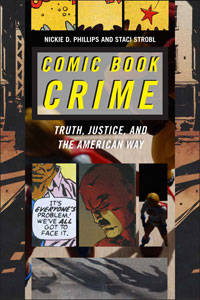Since display in their wishful thinking of readers, the sense justice following punishment heroes. There is a simple truth, namely that an entirely forgiving and tolerant superhero will ultimately lose its readership and is doomed to disappear from the stores otherwise. To fight crime, protect the helpless and step in where the police would not help actually was the reason why the superhero appeared.
A nd he would not constantly obey the law either, when enforcing justice and violently punishing the crooks, gangster, thugs and murderers of the city. Crime, violence and punishment then are invariably at the center of the superhero comic.
nd he would not constantly obey the law either, when enforcing justice and violently punishing the crooks, gangster, thugs and murderers of the city. Crime, violence and punishment then are invariably at the center of the superhero comic.
Already readers in the late 1940s could write to the editors of American comic books and voice criticism, suggest plots and question story lines on an extra page (usually in the back) of the comic book. How exactly a villain was taken care of by the hero was the topic of a high number of letters.
This fact and various other channels (blogs and online forums in the last twenty years) by which comic book readers could influence the outcome of continuing long story arcs, and the fate of certain characters were actually a marketing tool used by the editors, since published fan letters, in turn made the reader feel important. Sometimes reader polls decided on those pages would turn a story outline. Simultaneously, the editors would find out if the respective hero did punish the right people the adequate way, according to the fans.
“Reading comic books is a way of expressing retribution and vengeance that is short-lived and contained within the context of ‘fantasy’ … […] In fact, at the moment of consumption, readers themselves express a visceral, emotional desire to engage violently with the bad guys.”
This is where Nickie Phillips’s and Staci Strobl’s analysis sets in. The heroes and villains that are at the center of the total body of 200 comic books published between 2002 and 2010, which were singled out to have data for a scientific and statistical analysis of both crime and (legal and vigilante) retribution from the hands of the heroes, are inspected carefully. The authors also questioned readers about their expectations of crime, gore, violence, and retribution, attended academic comic book conferences and conventions to find out the acceptance of that audience.
The long list of verdicts, punishment and sometimes torture that finally appears on the comic book pages is not only a possible mirror of how “man” stands up against crime and injustice but also shows the inner conflicts of the superheroes, their development, sense of honor, justice and sympathy – which in turn, is not so different from the inner conflicts of the average comic book reader.
Any book on this interesting feature of comics would be rare enough if it came from a mere comic fan, but the two authors of this study are professional experts on American law who can pass better judgment on the actions of the heroes. Nickie Phillips is Associate Professor in the Sociology and Criminal Justice Department at St. Francis College in Brooklyn, NY, while Staci Strobl is Associate Professor in the Department of Law, Police Science and Criminal Justice Administration at John Jay College of Criminal Justice.
Equipped with this background and experience, a whole number of critical points in the behavior patterns of the heroes who often are judge, jury and executioner at the same time are investigated with cultural criminological sensibility. Even though it is ultimately difficult to decide which punishment should await a (comic book) murderer, terrorist, tormentor or kidnapper, the two editors show entertainingly show the changes in the conduct of the heroes throughout the decades.
They naturally consider the effects of the Comic Books Code of the 1950s, its later abolishment, the introduction of fresh heroes in the Silver Age, the new aspects of crime after 9/11, ethnicity, race, sexual orientation and gender in connection with crimes committed and punished, as well as the changing reactions of the readers to these and many more adjustments in the superhero cosmos.
It is compelling to learn that very often comic book violence and retribution are only communicated verbally by the superheroes; the mere reference seems to have almost the same satisfying effect on the reader. The findings of the two authors, nevertheless, differ, since they researched many different comic book series from various publishers. So merciless “… incapacitation [of the villains] has the emotional quality of vengeance that is realized through action-oriented, extra-legal plot developments. In essence, our sample of comic books frequently talked tough, looked bloody, but ultimately contained threats of retribution rather than full execution of it. At the same time, our sample tended to devalue nonviolent conflict resolution and was devoid of any critical or radical explanations for criminal behavior.”
Comic Book Crime: Truth, Justice, and the American Way is an impressive study that investigates not only comic book culture but the conditions of fictional worlds where a different sense of justice is at work. So, obviously, the comics present an alternate American society; and the book also takes a look at the development of the American law system and its possible flaws, past and present corruption and other imperfections that called for fictional heroes such as Batman and Superman in the first place.
Review by Dr. A. Ebert © 2014
Nickie D. Phillips and Staci Strobl. Comic Book Crime: Truth, Justice, and the American Way (Alternative Criminology). New York University Press, 2013, 295 p.
